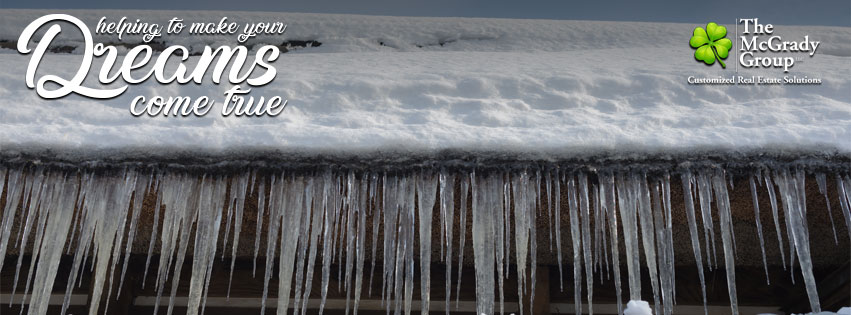ICE DAMS, WHAT DO THE EXPERTS SAY?
What are Ice Dams?
Ice dams are formed by continual thawing and refreezing of melting snow. Large masses of ice develop as snow on the upper part of the roof melts. The water runs under the snow and refreezes at the edge of the roof.

Additional snow melts and forms pools against the dam, gradually causing water to back up on the roof where it often gets under the shingles and eventually into the house. Causes other than heat escaping from the home include:
- Bright sunshine melting the snow;
- Insufficient attic insulation allowing the heated air of the attic to reach the roof deck and melt the snow, which could happen anywhere on the roof surface;
- Naturally occurring ice accumulation due to various weather conditions;
- Poorly placed gutters preventing snow and ice from sliding off the roof;
- Inadequate attic ventilation.
The latent damage from ice dams may not be immediately evident. For example, insulation could be getting wet and over time will lose its ability to perform properly. In addition, mold may begin to grow in the moist attic environment. Although ice dams are more prevalent at the eaves, they can (and do) occur anywhere on the roof, especially where there is a change in roof surface temperatures.
Can This Be Avoided?
Wisconsin weather is challenging to say the least and, as we all know, there is only so much you can do to avoid its impact. But, having said that, there are some things you can do to minimize the risks of developing ice dams on your roof.
- If you have a large deposit of snow, particularly in bad areas like a valley running into a wall or a saddle area, removing the snow is your best option. Any large deposits at the eaves, especially on the north side, should be removed as well.
- Install a leak barrier such as StormGuard® or WeatherWatch® Leak Barrier. These impermeable membranes prevent water from entering through the roof deck.
- Improve attic insulation in order to keep the attic space cool, thereby reducing the amount of melting snow.
- Improve attic ventilation to ensure that the attic remains cool.
- Make sure that your gutters or eavestroughing are lower than the slope of the roof, allowing snow and ice to glide off.
What Kind of Salt Can You Put on Your Roof for Ice Dams?
By Jason Thompson Icicles hanging from your eaves may look pretty but signify a real problem.
Ice dams occur when the warm air in your attic melts the snow on your roof, causing it to run down the roof toward the ground. When it hits the eaves and breaks contact with the warm attic roof, the frigid air refreezes the water. As new melt hits the ice, it also freezes, building up the dam and can even be forced back up under your shingles and into your roof and attic, causing water damage, ruining your insulation and creating ideal conditions for mildew growth. Though salt may seem like the best melting solution, several salts can cause other damage to your roof or gutters.
ROCK SALT

Rock salt is common for de-icing driveways and paths. It should be no surprise then that it is the first thing many people think of to remove ice dams. However, rock salt is a form of sodium chloride, which corrodes metal, including the metal nails holding your shingles in place. Rock salt can also leave permanent stains on your roof and walls. It also does not work well below 20 degrees Fahrenheit. For these reasons, rock salt is not a good choice when it comes to getting rid of ice dams.
TABLE SALT

Some people use table salt for de-icing instead of rock salt. However, this is no better, as chemically they are the same substance. Table salt is just rock salt broken down into smaller crystals. It will corrode and stain just like rock salt does. Breaking the ice up with tools is also a bad idea, as that can easily damage your roof even worse than the rock salt could.
MAGNESIUM AND POTASSIUM CHLORIDES

Magnesium and potassium chlorides also both melt ice. However, magnesium chloride is only effective if temperatures stay above 5 degrees Fahrenheit. Potassium chloride loses effectiveness below 12 degrees.
CALCIUM CHLORIDE
Calcium chloride is the best salt to use on ice dams, according to handyman Glenn Haege. It is not as likely to stain or cause corrosion as sodium chloride, but it can damage wooden gutters. It melts ice faster than sodium chloride does, works at lower temperatures than sodium chloride and also melts larger volumes of ice. It works at lower temperatures than either magnesium or potassium chloride.
USING CALCIUM CHLORIDE
However, simply scattering calcium chloride across your entire ice dam, hoping to melt it, is not likely to work well. Plus, this would be an inefficient use of salt even if it does work. An ice dam can easily be made of hundreds of gallons of water, so melting it all requires a lot of salt. Instead, fill old pantyhose with the calcium chloride and lay it across the dam. This will melt a channel to allow water to safely run off your roof and break up the dam for manual removal.




